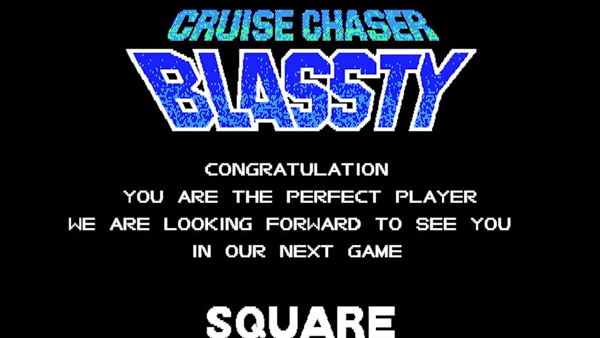Plenty of video games in the 1980s borrowed the look and style of contemporary anime, but Cruise Chaser Blassty was unusual. It wasn’t just the involvement of a legendary animation studio and staff that would go on to create one of the biggest game franchises in history, but it became more than just a game and seemed destined for more.
In retrospect, combining the mecha animation prowess of Nippon Sunrise (Mobile Suit Gundam, Fang of the Sun Dougram, Space Runaway Ideon) with the game design talent of Square (Bushido Blade, Front Mission, Final Fantasy), seems like a wonderful idea. Efforts to replicate the look of contemporary anime in video games during the ‘80s were inherently limited, as rudimentary graphics couldn’t quite match the over-the-top animation of the era – but if anyone was going to do it, surely it’d be those two companies, right?
As it turned out, no.
 クルーズチェイサー ブラスティー
クルーズチェイサー ブラスティー
Cruise Chaser Blassty
Released April, 1986
7,800円
PC-8801mkIISR, PC-9801VM/UM, X1
Cruise Chaser Blassty was released in 1986, when the pasocon were basic and Square was largely known for Japanese PC games like The Death Trap. Despite some impressive graphics, Blassty’s dungeon-style gameplay didn’t match its outer space sci-fi setting and three decades later it proves to be exceptionally difficult game to recommend playing.
The game centers on a space station called Ondina and a rebellion against the organization that runs it named the “Commune.” Bounty hunter Inker Mars pilots the titular mecha through a series of battles, both inside the station and in space, that look a lot like Wizardry and every other “3D” dungeon crawling game of the time. That’s certainly not an ideal format for a game about fast-moving robots in space, but the limited movement in space is explained with the existence of “anti-matter” meteors that hinder your movement.

“Robot Animation Type” RPG
The popularity of mecha anime served as inspiration for numerous games during the 1980s, although hardware performance typically limited how well they emulated their video inspiration. PC hardware of the era was better suited for displaying detailed, but largely static, images rather than the numerous sprites necessary for traditional action games like you’d find on the Nintendo Famicom (NES). As a result, adventure games were commonplace on PCs, with impressive graphics that were big on detail. That style of game was well-suited to emulating anime, however, as it had the detail and fidelity to replicate hand drawn animation.

One noticeable exception to this was Metal Slader Glory by HAL Laboratory, released for the Famicom. It used a specialized chip for its detailed graphics and came out so late in the Famicom’s life cycle that the Super Famicom had already been released. It was remade for the Super Famicom in 2000, well after the release of that system’s successor, the Nintendo 64.
Mechanical design and animation for Blassty were handled by Sunrise, a production studio that was riding the ‘80s giant robot wave by having a hand in nearly every major mecha show of the era. According to the second issue of Challenge!! Pasocon ADV & RPG, originally Square had been considering collaborating with Buichi Terasawa (Cobra), Yasuhiko Yoshikazu (Mobile Suit Gundam, Venus Wars), or Hayao Miyazaki for the game’s animation, although it’s unclear if they were planning to deal with those creators directly or with them and Sunrise. Regardless, all three were too busy to take on the project and Square ultimately just collaborated with Sunrise. This worked out well, as Sunrise had been interested in working on a project utilizing computer graphics. The game’s mechanical designs were handled by Mika Akitaka, best remembered today for his work on Martian Successor Nadesico, but also responsible for the original MS Girls phenomenon of the late ‘80s.
While the game’s battle animation is impressive – reportedly 10 frames per second, buddy – actually playing it is a fantastic way to test your patience. For starters, you’ll either have to break out the paper and pencil or read a guide, because while there’s an option to check your coordinates, it’s not mentioned anywhere in the game’s manual. It was, after all, the ‘80s and games were designed to make you suffer. Regardless of if you use your own hand-drawn maps or the game’s mapping system, it’s still easy to get lost in the space dungeons. It’s also written entirely in katakana (with some English), a feature that might entice those with a limited kanji knowledge but in reality is actually far, far worse. If the repetitive dungeons don’t get you, having to sound everything out in katakana will.

So Blassty looks and plays more like Wizardry with mecha than Final Fantasy, the role-playing game series that made Square famous, but plenty of people who would later make a name for themselves on that series worked on Blassty. Final Fantasy creator Hironobu Sakaguchi co-wrote the scenario and handled game design with Kazuhiko Aoi, who later worked on some of the earliest Final Fantasy sequels. Final Fantasy composer Nobuo Uematsu also made his professional debut writing the game’s music.
Square, of course, would go on to release Final Fantasy for Nintendo’s Famicom console in 1987. As the company’s reputation grew with the popularity of console systems, much of their pre-Final Fantasy catalog was left in the dust. Ask someone what early games Square was known for and it’s unlikely they’ll say Alpha, Aliens: Alien 2, or Blassty. But a lot of that comes down to visibility, by 1988 Square had ditched Japanese PC platforms entirely in favor of Nintendo. Blassty was strictly a PC game and was released on some of the dominant PC platforms of the era, including NEC’s PC-8801 and PC 98-01 and Sharp’s X1. That’s exactly where it stayed.

Despite being re-released as part of a retro-syle package (including the soundtrack on vinyl, just like the original release) by D4 Enterprise, Blassty has remained the stuff of hardcore PC history buffs or, oddly enough, fans with fond memories the magazine Hobby Japan. That’s because the legendary model magazine published a lot of Blassty material and in the process, likely did more for the Blassty name than the actual game did.

The Blassty of Hobby Japan
Shortly after the game’s release, Hobby Japan began running a serialization of the story and photo-spreads of scratch-built Blassty kits. This serialization, which was less a direct adaption and more of a reboot, was written by Yasushi Hirano and featured design and illustration work by Suzuki Masahisa and an in-house team at Sunrise called VISCIAL DESIGN. In this version, the Blassty is co-piloted by Christy and Freddie, who get caught up in a resistance group on Mars that rebels against the Inspection Agency, an organization that controls much of the Solar System.

The popularity of Blassty in the magazine was enough to inspire fan art, official model kits, garage kits, and novels that drew from Hobby Japan’s setting. The magazine even ran a satirical article that played into the obvious what-if scenario of the series getting an anime adaption. It included storyboards, cell-style illustrations and a rather conspicuous broadcast date of April 1.
When people think of Blassty’s designs today, they’re probably thinking of the series as it appeared in the pages of Hobby Japan. Compared to the chunky robustness of Akitaka’s original designs, Masahisa’s are much more delicate and spindly — so much so that they could almost pass for the work of Mamoru Nagano (Heavy Metal L-Gaim, Five Star Stories) if they weren’t so simultaneously utilitarian. The Hobby Japan setting redresses the Blassty as a deep-space exploration craft and it’s apparent in Masahisa’s redesign, which looks more like a ship that just so happens to transform into a robot. In comparison, the original design by Akitaka looks much more like a combat robot that can also transform into a ship.

Masahisa may be best known for illustrating the long-running novel series ARIEL, but has since done design work for everything from Fullmetal Alchemist: Brotherhood to Bodacious Space Pirates. VISCIAL DESIGN was a planning team comprised five Sunrise employees: writer and producer Shigeru Horiguchi (Gundam Evolve, SD Gundam Force), illustrator Hiroshi Kuwabara (Final Fantasy VII: Advent Children), Hiroki Suzuki, Nobutoshi Tsukada, and Tatsuhiko Yanagisawa. Using the Hobby Japan material as a springboard, Horiguchi would later write three Blassty novels for publisher Sonorama.
The Hobby Japan material was later collected into a single softbound book, The Art of Cruise-Chaser Blassty, that included lots of model kit photos, line art, and the original serialization. While garage kits based on the series have popped up at WonderFest over the years, the easiest to find is a soft vinyl kit released by Hobby Japan. Soft vinyl excels at smooth, organic lines and it’s not the best material for reproducing the sharp, spindly style of the Masahisa’s design, but it’s probably the easiest (and cheapest) Blassty kit to track down.
Today's mail, an old soft vinyl Blassty kit by Hobby Japan. pic.twitter.com/R2yTpuqI8P
— sukeban hecka ⭕️ (@colonydrop) May 23, 2017
That Blassty has continued to endure is thanks in no small way to the strength of its designs above all else. The particulars of the original game or the details of Hobby Japan’s serialization are easily forgotten, but while Masahisa’s mechanical designs were firmly planted in the ’80s, they’re still strikingly unique decades later. That’s why it’s 2017 but you can still pick up a t-shirt of an SD Blassty or a resin kit at this summer’s Wonder Festival. Good design work can live forever.

Special thanks to xenosynth for help with screenshots and gifs.
Further Reading
- Cruise Chaser Blassty [Japanese]
- Cruise Chaser Blassty at Gears Online
- Cruise Chaser Blassty Packaging [Japanese]
If you enjoy the content published on Zimmerit, please consider making a donation to support the site via ko-fi.com. This site is, and always will be, a passion project but donations help offset the cost of site upkeep, acquiring materials, and commissioning translations. Every little bit helps! Thanks for your support.

